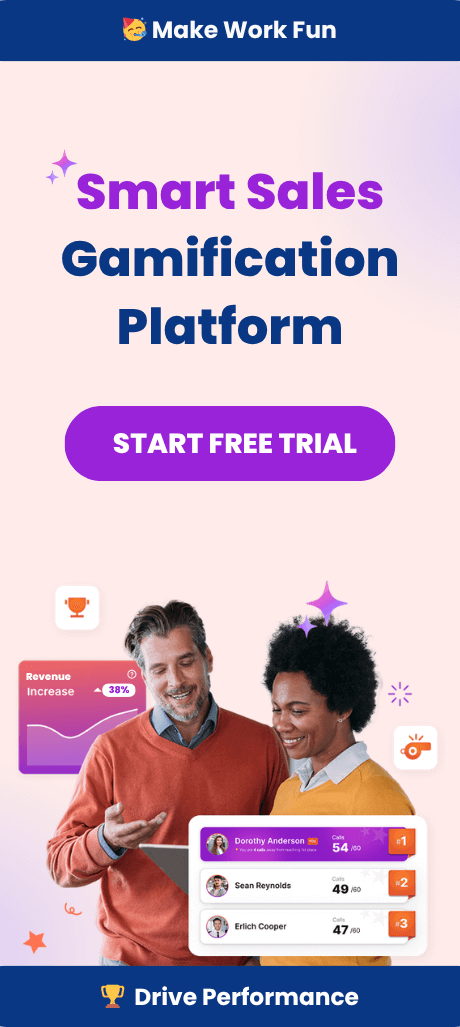Sales gamification is essentially the practice of incorporating the elements of modern game culture into the sales environment so as to reward your top talent and foster a culture that promotes recognition, employee engagement, and high performance. A motivated sales team is a successful sales team, and the name of the game when it comes to sales gamification is incentivization.
This article will go over how you can use sales gamification strategies to achieve better sales results; we will also look at some of the different options out there for incentivizing your sales team, along with some of the best sales incentives.
Understanding gamification
In one sense, gamification is very much another way of saying friendly competition. By turning sales into a game, you can attract and maintain the focus of your team members. There are various ways to gamify your sales unit, but the most effective strategy involves rewarding those who performed well with various bonuses such as prizes, experiences, cash considerations, and personal development opportunities. In other words, you offer some incentives that encourage your team members to try their hardest.
Does gamification really work?
Not only does gamification in sales work, but it may very well be the best framework by which you can cultivate a team of dedicated, engaged, high-performing employees. The reason for this is simple; gamification takes advantage of the principles of human nature. People want to succeed – to win. By turning the sales process into a game that rewards people who play well, you will see a tremendous payoff in terms of employee engagement, productivity, and ultimately sales.
How to incentivize your sales team
There are a few different options when it comes to gamifying your sales team. There is no one size fits all solution because each sales team is different, but we can offer a few ideas along with some tips and tricks for your consideration.
The first step is to set your budget. Determine how much money you can afford to spend on sales incentives and then select prizes that fit within your budget. Keep in mind that you don’t want to choose sales incentives that have a low value. Anything less than a $25 gift card is not going to motivate most people.
At the same time, your company is probably not willing to hand out new Ferraris, or maybe they are; the best gamified sales teams in the world do earn prizes of this nature, but when you’re just starting out, try to choose sales incentives that will encourage your team members to want to win.
Once you’ve determined your budget and selected a sales incentive, the next step is to figure out how you will track and record the progress of your team members towards those goals and objectives. There are a few options available.
You can elect to go with a software-based solution to track sales and monitor progress, or you can do it the old-fashioned way with internal software and a leaderboard that everyone can see. Either way, just make sure that you have a means by which to keep track of everyone’s performance, and always hand out sales incentives promptly when they have been earned.
The best sales incentives
If you want to have the most success with your sales gamification initiative, then it’s important that you choose sales incentives that will actually motivate people to make a tangible effort towards achieving the objectives that you have set. Some rewards are better than others for the purposes of sales gamification.
Let’s briefly go over some of the best sales incentives so that you can get a better idea of the different types of prizes that can be included in your gamification program.
1. Environment-based rewards
Environment-based rewards make the office more comfortable or enjoyable for employees who reach or exceed their targets and sales objectives. Some examples might be a better office, a fancy chair, a new desk with a better view, anything that will improve their level of comfort while they’re at work will be a great incentive; this is also a great type of sales incentive to offer because employees who are comfortable and feel appreciated at work are even more likely to perform well, keep engaged, and be committed to the company’s success.
2. Financial rewards
Financial rewards are the oldest and arguably the best motivator when it comes to sales incentives in a high-performance gamified sales environment. If people have a chance to win what they perceive to be free money, they will, in almost all cases, try their very best to win. By offering a cash bonus to the first employee to make X number of sales this week, you can be sure that it will be a close race with everyone in the office trying their best to win the prize.
The trick is to have a financial incentive that is at least somewhat significant. A $20 bonus for the first person to make ten sales is unlikely to inspire much more than snickering, a $200 bonus, on the other hand, or a $2000 bonus depending on what the team is selling, and the dollar amounts involved will be much more likely to have a positive effect on your team’s performance, and productivity.
3. Experiential rewards
Experiential rewards are sales incentives that involve winning a prize that features some sort of experience, such as tickets to a concert or sporting event, dinner for two at a nice restaurant, or even a cruise or all-inclusive vacation. Earning cash and prizes is always a fantastic feeling, but winning an experiential reward feels much more personal and can encourage your highest earners to remain committed to you and your company’s success in the long run.
4. Career-centric rewards
Finally, you can offer the good old-fashioned incentive of a promotion or career development opportunities. For example, maybe the team member with the most sales this year is automatically promoted or receives a tuition credit towards managerial training or some other educational incentive that will further their career. These types of incentives attract a lot of engagement from employees already committed to your company, and those are exactly the employees you want to cultivate into sales superstars.
Summary
By using sales gamification strategies, you can increase your team’s engagement and productivity levels significantly. When people stand to gain something, they tend to put in their best effort, especially if it’s something that they value and desire to have; by incentivizing your sales unit and implementing a reward-based system such as is found in modern gaming culture, you will be able to cultivate a high-performance team, that is committed to closing deals and making sales consistently.



